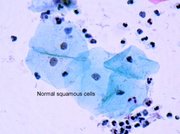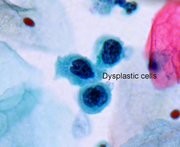Definition
Cervical dysplasia is the existence of abnormal cells on the cervix.
Description
The cervix is an organ in the female reproductive system, narrow located at the lower end of the uterus. The cervix serves as a tubular passageway between the uterus and vagina. When a woman is pregnant, the cervix closes and seals off the uterus for the developing fetus. During childbirth, the cervix expands to allow the baby to pass through. When a woman is not pregnant, the lining of the uterus passes through the cervix each month during the menstrual cycle. The cervix also secretes mucus during ovulation, which assists in the fertilization of the egg by sperm cells. Women can usually feel the cervix by inserting a finger toward the back of the vagina. The cervix resembles a small mound with a dimple in the middle.
The cervix has two types of cells. The outer part of the cervix near the vagina is covered with cells called squamous epithelial cells. The cervix canal is lined with epithelial cells that secrete mucus during ovulation. The border between these two types of cells is called the transformation zone, which changes shape and position with age. Doctors may closely examine the transformation zone to watch for problems in both types of cells.
Cervical dysplasia occurs when cells on the cervix have abnormalities. The condition is technically called cervical intraepithelial neoplasia (CIN) or squamous intraepithelial lesions (SIL), depending on the affected cells. The cervix is also susceptible to other problems, including cervicitis (inflammation), sexually transmitted diseases (STDs), infections, and cancer (dysplasia is a precursor to cancer).
Causes & symptoms
The two factors that create the highest risks for cervical dysplasia are smoking and sexual behavior. Cervical dysplasia is two to three times more likely to occur in women who smoke than in those who do not. One study showed that the risk of dysplasia increases directly with the number of cigarettes a woman smokes per day. Nicotine, a toxin in cigarette smoke, can be found in the cervical cells of smokers.
Sexual behavior is another major risk factor. Studies have shown that the presence of sexually transmitted diseases are strongly correlated with the occurrence of cervical dysplasia. Women who have human papillomavirus (HPV), which causes genital warts , have higher occurrences of cervical dysplasia. Other STDs are believed to influence cervical dysplasia as well, including herpes, hepatitis B and C, and HIV. Risky behaviors for contracting STDs and cervical dysplasia include having many sexual partners, having intercourse at a young age, and having unprotected sex.
Other factors that influence the development of cervical dysplasia are the long-term use of birth control pills, the use of immunosuppressive drugs (drugs which weaken the immune system), and deficiencies of folic acid , vitamin A , and vitamin C . Folic acid deficiency is often observed with heavy alcohol consumption, which may indirectly pose a risk as well, as may drug abuse. Cervical dysplasia has also been observed to have higher incidence in women in low income groups.
Cervical dysplasia is generally asymptomatic, which means that most women are not alerted to the condition by detectable symptoms. To detect cervical dysplasia, women must rely on diagnostic tests.
Diagnosis
The most common method for diagnosing cervical dysplasia is the Pap smear, which was invented by the American researcher George Papanicolaou in the 1950s. Due to the effectiveness of the Pap smear in detecting cervical problems, the incidence of cervical cancer has decreased by as much as 50% since 1960. Deaths from cervical cancer have decreased by as much as 70% in groups of women who get frequent Pap tests.
The Pap test is a simple procedure. A doctor inserts a small brush and obtains a sample of cervical cells that are then analyzed under a microscope. Cell abnormalities, or cervical dysplasia, can be classified as low grade or high grade, or ranked numerically. A Class 1 Pap result is normal, Class 5 represents cervical cancer, and the numbers in between indicate relative severity. It should be noted that the Pap smear is not perfectly accurate. In 20% or more of tests, the Pap smear can fail to find problems. The Pap smear may also overestimate the severity of abnormalities. Thus, if dysplasia is found for the first time, it is a good idea to have follow-up Pap tests to confirm the diagnosis. To increase the accuracy of Pap tests, women should not douche or use a tampon for three days before an exam, should abstain from intercourse for two days, and should allow a week after menstrual periods or vaginal infections before having the exam performed.
If Pap tests continue to detect cervical dysplasia, other diagnostic tests may be ordered. A cervigram is a photograph of the cervix that can be performed alongside a Pap test. A colposcopy is a procedure in which a tiny camera allows the physician to view the cervix and the interior of the vagina. If cancer or severe problems are suspected after a colposcopy, a biopsy may be used, in which tissue from the cervix, vagina, and uterus is surgically removed in order to be analyzed. In a cone biopsy, a surgeon removes a cone-shaped section of the cervix to check for cancerous cells. Cone biopsies can cause permanent internal scarring, so women should carefully consider this procedure, particularly in cases where dysplasia is not severe.
Treatment
There are several alternative therapies that can be utilized for cervical dysplasia. During and after alternative treatment, cervical dysplasia should still be monitored by Pap smears from standard physicians, particularly for severe cases.
Dietary and nutritional therapies seek to balance the hormonal system and support the immune system. Diets for cervical dysplasia should be predominately vegetarian and low in fat, emphasizing fresh fruits, vegetables, grains, nuts, and legumes (beans and lentils). Alcohol, caffeine, fried foods, and sugar should be avoided, as should foods that may contain artificial hormones and estrogen, such as dairy and meat products that are not organically produced. Women should eat plenty of yellow and leafy green vegetables. Tomatoes contain a substance called lycopene that may protect against dysplasia. Soy products should also be frequently added to the diet, for their estrogen balancing effects.
Nutritional support includes the supplementation of B-complex vitamins, particularly folic acid, vitamin B6, and vitamin B12 . Vitamins A, C, and E are recommended, as are the minerals selenium and zinc. Grape seed extract and pine bark extract are recommended antioxidants to assist healing, and nutritional yeast and spirulina are natural supplements for B vitamins and minerals.
Recommended herbs include vitex berries (also called chasteberries, or chasteberry tree ) and black cohosh to balance hormones and stimulate healing in the reproductive system. Herbs to stimulate and support the immune system include echinacea, goldenseal, burdock, milk thistle , shiitake mushrooms, yarrow, ginger, and astragalus. Herbs that may balance hormones include red clover , kudzu root, licorice root, and Siberian ginseng. Aromatherapy baths may also help, utilizing the essential oils of geranium, rose, lavender, bitter orange, rosemary, or tea tree oil . Herbal douches and herbal vaginal suppositories are available that utilize herbs and essential oils to stimulate internal healing.
Exercise is recommended to stimulate the immune system and reduce stress. Yoga has exercises specifically designed to stimulate circulation in the lower abdomen and reproductive organs. Plenty of fresh air during the day is also beneficial for those trying to improve their health and energy.
Stress and emotional problems may also play a significant role in cervical dysplasia and in problems with the reproductive system in general. Mind/body techniques such as psychotherapy, meditation, progressive relaxation, breath work, and visualization may help reduce stress, remove emotional blockages, and stimulate healing. Detoxification therapies may also be recommended, including fasting, sweating, and other techniques, particularly for women who may have accumulated toxins in the body from smoking, drug abuse, or poor dietary and lifestyle habits.
Allopathic treatment
For mild cases of cervical dysplasia, physicians may choose to monitor a patient with Pap smears every three months, to determine if the condition can improve on its own. For severe or chronic cases of dysplasia, allopathic treatment seeks to remove or destroy abnormal cells on the cervix. Cryosurgery destroys dysplastic cells by freezing them. Abnormal cervical cells can be burned off with a solution of trichloroactetic acid. Laser surgery may also be employed, as well as the loop electroexcision procedure (LOOP), a surgery in which a small wire loop with an electrical charge is used to destroy abnormal cervical cells. Conventional surgery may be used for severe cases of dysplasia. Partial hysterectomies remove the uterus and cervix.
Expected results
Several outcomes are possible with cervical dysplasia. In some cases, dysplasia may clear up completely without medical intervention. Some statistics have shown that moderate to severe cervical dyplasias (Class 3) improve on their own in 50% of cases. Mild dysplasia may progress to severe dysplasia in up to 25% of cases, as some studies have shown. Cervical dysplasia does not directly progress to cervical cancer, especially when it is detected early and treated. In some studies, cervical dysplasia progressed to cervical cancer in approximately 15% of cases that were not diagnosed and treated properly. Cervical cancer is the second most common malignant cancer in women between the ages of 15 and 34. When detected early by frequent Pap smears and other tests, cervical cancer is very treatable. One study estimated that cervical cancer is fatal for 1 in 30,000 women.
Prevention
Women should eliminate risky sexual behaviors and should immediately quit smoking. Healthy dietary and lifestyle habits should be adopted, and birth control pills should be avoided. Pap tests and gynecological exams should be performed once a year or more to monitor for recurring dysplasia.
Key Terms
- Gynecologist
- Medical doctor specializing in women's reproductive disorders.
- Uterus
- Female reproductive organ that contains the developing fetus during pregnancy.
Further Reading
For Your Information
Books
- Blum, Jeanne. Woman Heal Thyself: An Ancient Healing System for Contemporary Women. New York: Tuttle, 1995.
- Hobbs, Christopher and Kathi Keville. Women's Herbs, Women's Health. Loveland, Colorado: Interweave Press, 1998.
- Morgan, Peggy and the Editors of Prevention Magazine. The Female Body: An Owner's Manual. Emmaus, PA: Rodale, 1996.
- Northrup, Christiane, M.D. Women's Bodies, Women's Wisdom. New York: Bantam, 1994.
Organizations
- The Health Resource. 209 Katherine Drive, Conway, AR 72032. (501) 329-5272.
Other
- Health Wisdom for Women. 7811 Montrose Road, Potomac, MD 20854.(800) 804-0935.
Gale Encyclopedia of Alternative Medicine. Gale Group, 2001.



